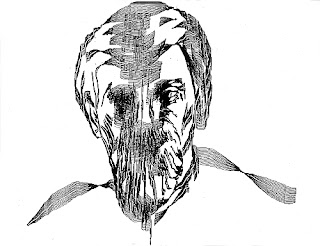Charles A. Csuri, an American artist born in 1922, is
considered one of the pioneers of digital art. He began experimenting with
digital art in 1964, making computer animated films and digital 2D artwork.
Many of his pieces used algorithms and different softwares that he created. He
has been creating digital art for more than 40 years, since the beginning, when
they were designing the software needed to create different affects and he is
still alive and creating digital art.
His piece
from the reading, Sine Curve Man,
made with James Schaffer, is a portrait of a man who is distorted or seems to
be melting. They created the effect by laying one image of a man over top of
another and displacing them using sine waves. You can see the separate lines of
each image, creating a sort of echoing effect, sort of like when an image on
film is distorted when a signal or connection is being lost. It seems like
there is a glitch and the image keeps repeating when it shouldn’t be, and the
result somewhat disturbing and gruesome. The face looks like it has been
mutilated or distorted in some way. Unlike many people working in computer art,
Csuri actually had a background in art. He was a painter, which can be seen in
a lot of his work. Many of his pieces, like combinePICS_1974, have a more
classical look to them. This image in particular looks like a virtual 3D still
life. The background looks like paint, but is clearly pixelated at the same
time. Also, there is a strong light source one what appears to be oranges,
again characteristic of a still life. There are many images similar to this
one, images containing spherical 3D shapes that are only partially there, with
a sense of fantasy to them. And again, most of his work is using specific
algorithms to create the art.
Sine Curve Man
combinePICS_1974
Infinite Universe
Frozen Moment
astroTEX
Citations:
http://www.csurivision.com/
http://www.siggraph.org/artdesign/profile/csuri/

























